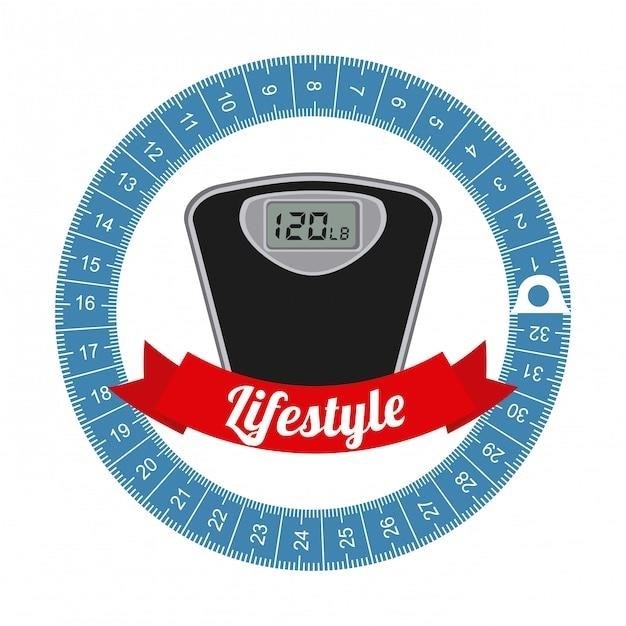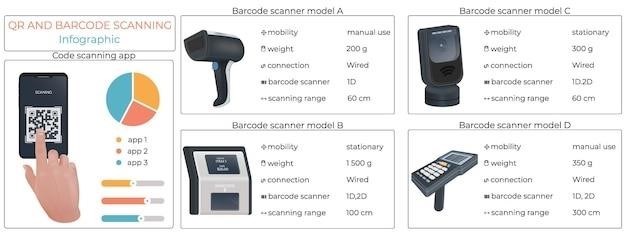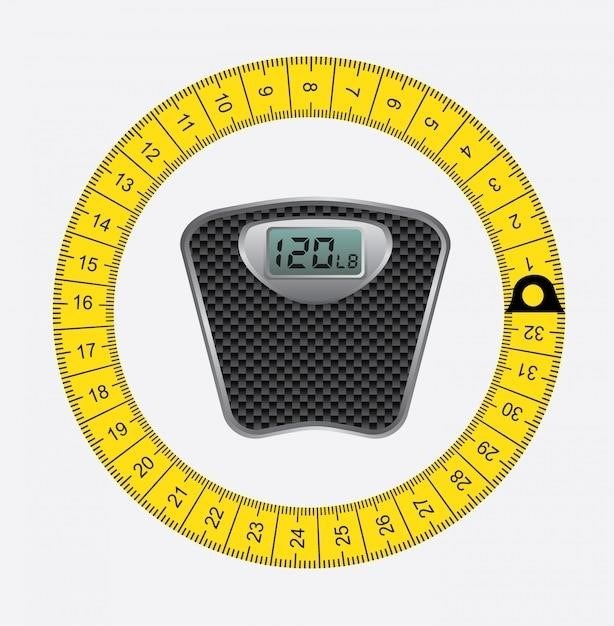Omron Scale Manual⁚ A Comprehensive Guide
This comprehensive guide provides a detailed walkthrough of your Omron scale, covering setup, calibration, weight and body composition measurement, result interpretation, troubleshooting, online manual access, maintenance, and customer support contact information․ Master your Omron scale today!
Understanding Your Omron Scale Model

Before delving into the specifics of using your Omron scale, it’s crucial to understand your specific model․ Omron offers a range of scales, from basic weight-measuring devices to sophisticated body composition analyzers․ Knowing your model number (e․g․, HBF-514C, BF511, SC-150) is paramount․ This number, typically found on a sticker on the scale’s underside or in the packaging, allows you to access the correct manual and understand its specific features and capabilities․ Different models offer varying functionalities, such as BMI calculation, body fat percentage measurement, skeletal muscle mass analysis, and even Bluetooth connectivity for data syncing with mobile apps․ Consult your user manual, readily available online or through Omron’s website, to fully grasp your scale’s unique features and limitations․ Understanding your model is the first step towards accurate and effective weight and body composition monitoring․
Familiarize yourself with the buttons and displays present on your Omron scale; Typically, you’ll find power buttons, unit selection (kg/lbs), and potentially buttons for accessing memory functions or advanced features․ A clear understanding of the control panel will streamline the process of using your scale․ The display screen will show your weight and potentially other metrics, depending on the model․ Note the symbols and abbreviations used on the display to ensure a correct interpretation of the data․ This initial understanding will greatly enhance your overall experience using your Omron scale․
Key Features and Specifications Across Omron Scale Models
Omron scales boast a variety of features depending on the model․ Basic models primarily focus on accurate weight measurement, displaying the weight in kilograms or pounds․ More advanced models incorporate body composition analysis, providing insights into body fat percentage, skeletal muscle mass, and BMI (Body Mass Index)․ Some models even offer additional features like visceral fat measurement, resting metabolism estimation, and body water percentage calculation․ These advanced features provide a more comprehensive understanding of your overall health and fitness․ Accuracy varies across models; while most offer precision to within 0․1 kg or 0․2 lbs, higher-end models may boast even greater accuracy․ Weight capacity also differs, with some models accommodating users up to a maximum of 150 kg (330 lbs) or more, while others have lower limits․ Consider your individual needs and preferences when selecting a model; a simple weight scale suffices for basic tracking, while advanced models are beneficial for those seeking detailed body composition analysis․ Always check the product specifications before purchase to ensure the chosen model aligns with your requirements․
Beyond the core functionalities, consider additional features like memory storage for multiple users, guest mode for occasional use, and automatic shutoff to conserve battery life․ Bluetooth connectivity is becoming increasingly common in newer Omron scale models, allowing seamless data synchronization with health and fitness apps on smartphones and tablets․ This allows for convenient tracking and monitoring of weight and body composition trends over time, providing valuable data for informed health decisions․ The availability of these additional features will vary significantly across the Omron scale range, so carefully evaluate these aspects when making a purchase․
Setting Up and Calibrating Your Omron Scale
Begin by carefully removing your Omron scale from its packaging and inspecting it for any damage․ Place the scale on a hard, flat, and level surface․ Avoid using the scale on carpets or uneven flooring, as this can affect accuracy․ Ensure the surface is free from any obstructions or debris․ Most Omron scales require batteries; consult your specific model’s instructions for battery type and installation․ Insert the batteries correctly, paying close attention to polarity․ Once the batteries are installed, the scale should power on automatically, displaying a zero weight reading․ If not, refer to your model’s manual for specific instructions on powering on the device․ Some models require initial setup, such as selecting your preferred unit of measurement (kilograms or pounds) and/or personal data entry (like age and height for body composition analysis)․ Follow the on-screen prompts or consult the user manual for guidance․ Many Omron scales incorporate a self-calibration feature․ This usually involves simply stepping onto the scale and then stepping off; the scale will automatically calibrate itself․ However, it is recommended to check your model’s manual for detailed calibration instructions, as the process might slightly vary․ Regular calibration ensures the scale maintains its accuracy over time․ Always refer to the provided user manual for your specific model as procedures and settings can differ․
Measuring Weight and Body Composition⁚ A Step-by-Step Guide
To measure your weight, simply step onto the Omron scale barefoot, ensuring your feet are positioned evenly on the platform․ Remain still while the scale registers your weight․ The display will show your weight in your pre-selected unit (kg or lbs)․ For body composition analysis (if your model supports this feature), you will need to follow specific instructions, which may vary slightly depending on the model․ Generally, you’ll need to hold the designated hand grips or touch the designated sensors while the scale performs a bioelectrical impedance analysis (BIA)․ This BIA measures the resistance of electrical currents passing through your body to estimate body fat, muscle mass, and other metrics․ Before starting a body composition measurement, ensure that you are properly hydrated; this improves the accuracy of the reading․ Avoid measuring your body composition immediately after strenuous exercise, as this can affect the results․ Some Omron scales offer memory functions, allowing you to store multiple user profiles and track your progress over time․ Consult your user manual for details on adding and managing user profiles․ Always ensure the scale is properly calibrated before each use to maintain measurement accuracy․ Understand that the readings provided are estimates, and results may vary slightly depending on various factors․ Regularly check your Omron scale’s user manual for detailed instructions specific to your model․
Interpreting Your Results⁚ Understanding BMI, Body Fat, and Muscle Mass
Your Omron scale provides valuable data for health monitoring, including Body Mass Index (BMI), body fat percentage, and skeletal muscle mass․ BMI, calculated from your weight and height, indicates whether you fall within a healthy weight range․ However, BMI alone doesn’t consider body composition; individuals with high muscle mass might have a higher BMI despite being healthy․ Body fat percentage represents the proportion of your body weight that is fat․ High body fat percentage is linked to various health risks, while a healthy range contributes to overall well-being․ Skeletal muscle mass reflects the amount of lean muscle tissue in your body․ Maintaining adequate muscle mass is crucial for metabolism, strength, and overall physical function․ The Omron scale’s interpretation of these metrics may vary slightly from medical professional assessments․ These readings serve as a helpful guide for self-monitoring and tracking progress towards your health goals․ Always consult a healthcare professional for personalized advice and interpretations, especially if you have health concerns or specific medical conditions․ Remember that consistent monitoring, coupled with a balanced lifestyle, including diet and exercise, significantly impacts your overall health and well-being․ Regularly review your results to identify trends and adjust your lifestyle accordingly for optimal health outcomes․ Use this data as a tool to empower yourself in making informed choices․
Troubleshooting Common Issues with Your Omron Scale
Encountering problems with your Omron scale? Let’s address some common issues; If the scale displays “Err,” ensure it’s on a flat, stable surface, free from carpets or uneven flooring․ Weight inconsistencies might result from not standing centrally on the scale․ Try recalibrating by stepping on and off the scale immediately after powering it on․ If inaccurate readings persist, check the batteries; weak batteries can cause erratic results․ Replace them with fresh ones of the correct type․ If the display is dim or unreadable, ensure the batteries are correctly installed and making proper contact․ Clean the scale’s surface regularly with a damp cloth to remove any dust or debris that might interfere with accurate measurements․ Avoid using harsh chemicals or abrasive cleaners․ If the scale fails to power on after checking the batteries and connections, refer to your Omron scale’s user manual for further troubleshooting steps or contact Omron customer support․ Remember, consistent maintenance and careful usage will ensure your scale continues providing accurate readings․ If the problem persists despite these troubleshooting steps, contacting Omron customer support is recommended for professional assistance․ Detailed troubleshooting tips are often available in the online version of your scale’s user manual․

Accessing and Utilizing the Omron Scale Manual Online
Accessing your Omron scale’s manual online is straightforward and convenient․ Begin by navigating to the Omron Healthcare website․ Their site usually features a comprehensive support section, often accessible through a clearly labeled “Support,” “Help,” or “Customer Service” link․ Once there, you’ll likely find a search bar․ Enter your Omron scale’s model number (e․g․, HBF-514C, BF511, SC-150) to quickly locate the appropriate manual․ The website should display a list of relevant documents; select the “Instruction Manual” or “User Guide” for your specific model․ These manuals are typically available in PDF format, allowing you to download and save a copy for offline reference․ Alternatively, you might find a direct link to the online manual within the search results․ The online manual usually provides detailed instructions, troubleshooting tips, safety precautions, and answers to frequently asked questions․ If you have trouble locating the manual online, consider contacting Omron customer support for assistance; they can guide you through the process or provide a direct link to the document․ Remember to check for updates to the manual periodically, as Omron might release revised versions with additional information or corrections․
Maintaining and Caring for Your Omron Scale
Proper maintenance ensures your Omron scale provides accurate readings for years to come․ Regular cleaning is crucial․ Use a slightly damp, soft cloth to gently wipe the scale’s surface, avoiding harsh chemicals or abrasive cleaners that could damage the finish or internal components․ Always ensure the scale is completely dry before using it․ Avoid dropping or subjecting the scale to significant impacts, as this can affect its accuracy and longevity․ Store the scale in a clean, dry place, away from direct sunlight, extreme temperatures, and moisture․ If the scale displays erratic readings or malfunctions, consult the troubleshooting section of your Omron scale’s manual․ If problems persist, refrain from attempting internal repairs yourself․ Contacting Omron customer support or an authorized service center is recommended for professional assistance and repairs․ They can diagnose the issue and suggest the appropriate course of action․ By following these simple maintenance steps, you’ll extend the lifespan of your Omron scale and guarantee reliable weight measurements for years to come․ Regular care ensures the continued accuracy of your measurements․
Contacting Omron Customer Support for Assistance
Should you encounter any difficulties with your Omron scale, accessing comprehensive support is readily available․ Omron offers multiple avenues for customer assistance, ensuring a swift resolution to any issues․ Their website, www․omron-healthcare․com, provides access to frequently asked questions (FAQs), troubleshooting guides, and downloadable manuals․ This online resource often answers common questions and resolves many problems independently․ For more complex issues or those not addressed online, contacting Omron’s customer support directly is recommended․ You can typically find their contact information, including phone numbers and email addresses, on their website’s support page․ When contacting support, it’s helpful to have your scale’s model number readily available to expedite the process․ Clearly describe the problem you are experiencing, including any error messages displayed on the scale․ Providing detailed information allows support representatives to accurately diagnose the issue and offer efficient solutions․ Remember to check the warranty information for your specific Omron scale model, as it may cover repair or replacement in certain circumstances․
